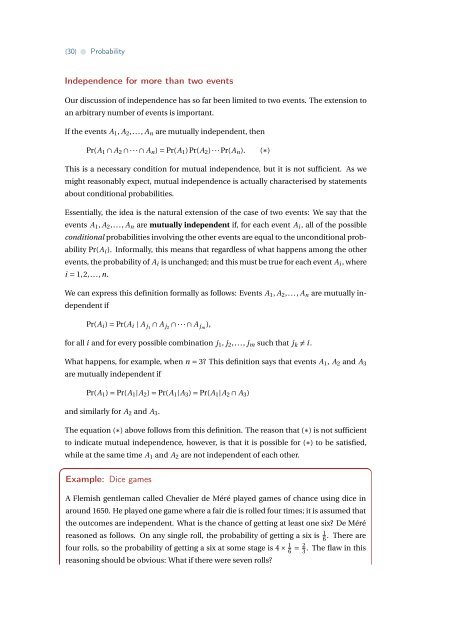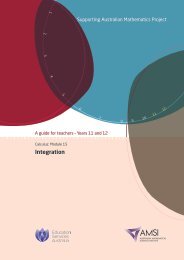Probability - the Australian Mathematical Sciences Institute
Probability - the Australian Mathematical Sciences Institute
Probability - the Australian Mathematical Sciences Institute
- No tags were found...
Create successful ePaper yourself
Turn your PDF publications into a flip-book with our unique Google optimized e-Paper software.
{30} • <strong>Probability</strong>Independence for more than two eventsOur discussion of independence has so far been limited to two events. The extension toan arbitrary number of events is important.If <strong>the</strong> events A 1 , A 2 ,..., A n are mutually independent, <strong>the</strong>nPr(A 1 ∩ A 2 ∩ ··· ∩ A n ) = Pr(A 1 )Pr(A 2 )···Pr(A n ).(∗)This is a necessary condition for mutual independence, but it is not sufficient. As wemight reasonably expect, mutual independence is actually characterised by statementsabout conditional probabilities.Essentially, <strong>the</strong> idea is <strong>the</strong> natural extension of <strong>the</strong> case of two events: We say that <strong>the</strong>events A 1 , A 2 ,..., A n are mutually independent if, for each event A i , all of <strong>the</strong> possibleconditional probabilities involving <strong>the</strong> o<strong>the</strong>r events are equal to <strong>the</strong> unconditional probabilityPr(A i ). Informally, this means that regardless of what happens among <strong>the</strong> o<strong>the</strong>revents, <strong>the</strong> probability of A i is unchanged; and this must be true for each event A i , wherei = 1,2,...,n.We can express this definition formally as follows: Events A 1 , A 2 ,..., A n are mutually independentifPr(A i ) = Pr(A i | A j1 ∩ A j2 ∩ ··· ∩ A jm ),for all i and for every possible combination j 1 , j 2 ,..., j m such that j k ≠ i .What happens, for example, when n = 3? This definition says that events A 1 , A 2 and A 3are mutually independent ifPr(A 1 ) = Pr(A 1 |A 2 ) = Pr(A 1 |A 3 ) = Pr(A 1 |A 2 ∩ A 3 )and similarly for A 2 and A 3 .The equation (∗) above follows from this definition. The reason that (∗) is not sufficientto indicate mutual independence, however, is that it is possible for (∗) to be satisfied,while at <strong>the</strong> same time A 1 and A 2 are not independent of each o<strong>the</strong>r.Example: Dice gamesA Flemish gentleman called Chevalier de Méré played games of chance using dice inaround 1650. He played one game where a fair die is rolled four times; it is assumed that<strong>the</strong> outcomes are independent. What is <strong>the</strong> chance of getting at least one six? De Méréreasoned as follows. On any single roll, <strong>the</strong> probability of getting a six is 1 6. There arefour rolls, so <strong>the</strong> probability of getting a six at some stage is 4 × 1 6 = 2 3. The flaw in thisreasoning should be obvious: What if <strong>the</strong>re were seven rolls?
















